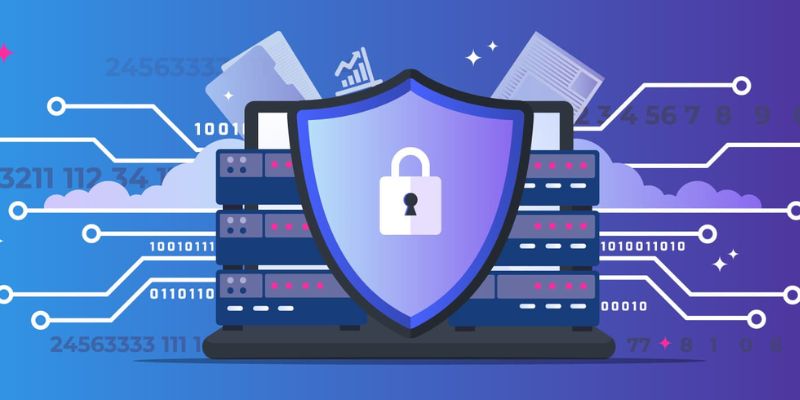Dive into the world where digital gold is safer than a steel vault. I’ll show you how What is blockchain security? transforms from a question to a bulletproof reality. We’ll start by breaking down the essentials, showing how cryptography locks down your assets tight. Then, we’ll talk trust – not the kind you give to your dog with your dinner on the table, but the kind built on rock-solid decentralized networks. No jargon, no fluff, just the meat and potatoes of keeping your blockchain uncracked and your investments snug as a bug. Join me, your friendly neighborhood blockchain expert, and learn how to fortify your digital domain against the cyber bad guys.
Understanding Blockchain Security Fundamentals
The Role of Cryptography in Blockchain
Think of cryptography like a super secret code. It keeps our blockchain safe. It uses math to lock away the info. This code is tough to crack. Only those with a special key can see the locked data. In blockchain, we use this code in a lot of ways. Hashing algorithms are one. They turn data into a jumble of letters and numbers. This jumble is unique. Change even a tiny part of the info, and the jumble changes big time.
Digital signatures are another way we use code. They prove who sent a message. They use a secret private key to sign. Others check the signature with a public key. It’s like sealing an envelope with a wax stamp. Only your stamp fits the seal. This combo of public and private keys keeps our blockchain sign-ins safe. No keys, no access.
Establishing Trust through Decentralized Networks
Decentralized networks are the heart of trust in blockchain. No single boss runs the show. Instead, it’s like a team playing together. Everyone has a copy of the data. Each copy must match for new info to add up. That’s our distributed ledger. It’s a group effort.
Secure blockchain protocols are like the team’s playbook. They have rules that keep our game fair. The rules help stop cheats like fake spending or pretending to be many players. Ever heard of a “51% attack”? That’s when someone tries to control more than half the team. If they do, they can mess with the ledger. But it’s really hard to pull off. You’d need a ton of power, more than a small country uses. Our team also double-checks work with consensus mechanisms. These are methods like “proof of work” or “proof of stake”. They make sure everyone agrees on what the ledger says. Sort of like a group thumbs up.
Finally, we keep an eye out for smart. They’re like glitches in our blockchain’s apps. They can let cheats in if we don’t fix them. Our job is to find these weak spots fast. Then, we patch them up so no harm’s done. It’s a bit like an endless game of whack-a-mole.
We’re the guards of the digital fortress. With big brains and cool tech, we keep your blockchain strong. Remember, it’s not just a chain; it’s a fortress, every block is a brick in its walls. And it’s our job to make it unbreachable.
Defending Against Common Blockchain Threats
Recognizing and Preventing 51% Attacks and Sybil Attacks
What can bring a blockchain to its knees? Two big threats are 51% attacks and Sybil attacks. A 51% attack happens when someone controls more than half of all mining power. They can stop new transactions or reverse ones they made. It’s like they own the blockchain! We stop this by using a mix of secure blockchain protocols and checks in the system.
We call strong rules that keep blocks safe protocols. Think of them like a digital armor. With these, even if someone tries a 51% attack, the blockchain stays tight and secure. It helps when more people join the mining process. More miners mean no one person can grab too much power. To avoid a 51% attack, we spread out the control. This way, the network doesn’t fall into the wrong hands.
Now, Sybil attacks. This is when one user fakes a bunch of identities. Like if one kid pretends to be a whole class to get more candy. Bad, right? We dodge this by making each user prove they’re unique. It’s through methods like needing to show some work before joining. This is like showing a secret handshake. If they can’t, no entry.
Strategies to Combat Smart Contract Vulnerabilities and Double-Spending
Smart contracts are like vending machines. You put in something, like money or data, and they give back what we want, automatically. But these can have weak spots called vulnerabilities. Bad actors can sneak in and mess things up like taking free candy from a broken machine. We always look for these weak spots and fix them with updates and testing. We call it an audit. It’s like checking a bridge for cracks.
And double-spending? It’s like spending one dollar twice. In the real world, you can’t, but in the digital one, some try to cheat. We use something called consensus mechanisms, like proof of work or proof of stake, to stop this. They are like a crowd of people all watching to make sure no one cheats. They check each transaction and if it’s good, they add it to the blockchain. This way, that one dollar can only be spent once. It’s all about agreement. Everyone agrees on what’s true and what’s fair.
In these defenses, we use hashing algorithms. They’re like secret codes that keep our data safe. And we use digital signatures to make sure that the person sending a message is really them. You can’t just copy someone’s signature. These are secrets only they should know.
For our keys, public and private, think of them like a mailbox. Anyone can drop a letter in (public), but only you have the key to open it (private). This is how we keep our blockchain mail safe. And we make sure that these keys are super safe. We lock them in a digital safe, called cold storage, or use multiple locks, called multisig wallets. That’s how secure we want our blockchain to be.
In the end, every step we take is for one goal: to make sure that this digital fortress stands tall, safe from invaders, and trusted by all who use it.
Preserving the Integrity of Blockchain
Advancements in Consensus Mechanisms: PoW and PoS
Blockchain security measures keep our digital treasures safe. They stop hackers and uphold trust. The backbone of this system lies in consensus mechanisms, like Proof of Work (PoW) and Proof of Stake (PoS). What are they, exactly? PoW makes network members solve hard puzzles to confirm new info, or “blocks.” PoS gives confirming power to members based on the number of coins they hold.
Let’s dig deeper. PoW is about doing work to get acceptance, just like miners digging for gold. It stops cheaters by making trickery cost more than what they gain. In short, honesty pays off. PoS is different. It runs on trust in wealth, not work. The more you own, the more you get to decide. This cuts energy use, which is good for our world.
The Critical Aspect of Blockchain Immutability and Node Security
Immutability is blockchain’s superpower. Once something’s in, it stays — no take-backs. How cool is that? This is all thanks to hashing algorithms, digital signatures, and node security. Hashing keeps data consistent. Change a tiny bit, and the whole hash changes. A digital signature is like a virtual fingerprint, confirming who sent info. Together, they’re like an unbreakable seal on your digital box.
But don’t forget node security. Think of nodes as guards at every block’s gate. They check and double-check each move using public and private keys, sort of like a super secret handshake only the cool kids know. Node security ensures no imposters get past the gate.
Now, what about those security threats to blockchain? Things like the 51% attack, where a group might control most of the network. They could twist the truth for their gain. Or Sybil attacks, where one bad apple pretends to be many, to mess with the network’s trust. But fret not; blockchain security measures are always evolving to stop these digital villains.
Wrapping up, maintaining a secure blockchain is a huge task. Yet, these robust security protocols are our front-line defense. And what’s more? Blockchain security standards are higher than ever before. We keep learning, improving, to ensure our blockchain fortress remains unbreachable. It’s not just tech; it’s our promise for a secure digital future.
Innovations in Enhancing Blockchain Cybersecurity
Addressing Quantum Computing Threats and Security Risks
We often hear about quantum computers breaking blockchain. But what’s the truth? Quantum computers can crack crypto, but they’re not yet strong enough. This matters because blockchain uses cryptography to keep data safe.
So, how do we fight this? First, by looking ahead. We’re creating new tech to stand up to quantum tools. Some smart folks work on quantum-safe cryptography. This means making codes that even future supercomputers can’t break. We always need to stay one step ahead of bad actors.
Implementing Robust Security Solutions: Cold Storage and Multisig Wallets
Now let’s chat about keeping your crypto safe. Have you heard about cold storage? It’s like a safe away from the net. It keeps your digital money offline. Bad guys can’t easily touch it this way. Plus, there’s multisig wallets. This means more than one key is needed to get to your coins. It’s like having several locks on your treasure chest.
Both of these methods help a lot. They add layers of security to your blockchain assets. Each layer acts like a guard, making it harder for thieves. Think of it like a castle. The more barriers it has, like walls and moats, the tougher it is to get inside.
To be clear, even with top-notch security, risks always exist. We can’t just set it and forget it. We need to keep checking, improving, and adapting our methods. For us in the blockchain world, it’s all about keeping the fortress unbreakable. Always evolving, always enhancing, to keep our digital world safe.
We’ve dug deep into blockchain security and covered some key parts. We started by looking at how crypto protects your data and how trust grows on networks with no central control. Then we moved to defend against big threats like 51% attacks, where someone might try to control a blockchain, and the tricky Sybil attacks. We also talked about stopping smart contract weaknesses and the issue with double-spending.
But, blockchain stays strong, partly because of how it records transactions in a way no one can change, and thanks to nodes that keep it safe. We’ve seen how new ways to reach agreement, like Proof of Work and Proof of Stake, play huge roles. And let’s not forget about the future—quantum computing could shake things up, so we’re getting ready with things like cold storage and multisig wallets to keep our blockchain space tight.
Remember, keeping blockchain safe is like a team sport. Everyone from coders to users has to play their part. Stay sharp, keep learning, and we’ll make sure our blocks are tougher than ever!
Q&A :
What Is Blockchain Security?
Blockchain security is a comprehensive risk management system for blockchain networks. It encompasses various cybersecurity frameworks, protocols, and features that are designed to protect the integrity and functionality of the blockchain ecosystem. By leveraging cryptographic techniques, consensus algorithms, and decentralized structures, blockchain security aims to safeguard against fraud, unauthorized access, and other threats.
How Does Blockchain Security Work?
Blockchain security functions through the use of advanced cryptographic methods, including hashing and encryption, to protect data. Each block in the chain has a unique hash that, once created, cannot be altered without altering all subsequent blocks. This, combined with a consensus mechanism such as Proof of Work (PoW) or Proof of Stake (PoS), ensures that all transactions are verified and agreed upon by the network participants, making unauthorized changes extremely difficult.
What Are the Key Features of Blockchain Security?
The key features of blockchain security include decentralization, which removes single points of failure; transparency, meaning all network participants can view transaction histories; immutability, which prevents the alteration of recorded data; and cryptographic hashing, which secures data integrity. Together, these features form a robust security protocol that defends against hacks and fraudulent activities.
What Are Common Threats to Blockchain Security?
Common threats to blockchain security encompass 51% attacks, where an entity gains control of the majority of the network’s hashing power; Sybil attacks, which involve creating numerous fake identities to subvert the network’s reputation system; and smart contract vulnerabilities, where code flaws can be exploited. Phishing, routing, and endpoint attacks also pose risks to users’ wallets and personal data.
How Can Blockchain Security Be Enhanced?
Enhancing blockchain security can involve several strategies, such as regularly updating and auditing smart contract codes to prevent vulnerabilities, implementing multi-signature wallets to require more than one key for transactions, and utilizing more robust consensus mechanisms. Strong network governance, continuous security monitoring, and educating users about best security practices are also vital in bolstering blockchain security.




RELATED POSTS
Cross-Chain Explained: Unlocking Multi-Blockchain Potential
What is Cross-Chain? Understanding the...
Security of Proof of Work: Is Your Cryptocurrency Safe?
Security of Proof of Work...
Unraveling the Mystery: Cryptocurrency vs. Blockchain Demystified
Understanding the Difference: Cryptocurrency vs....
Blockchain Decoded: How Does Blockchain Work For Beginners
How does blockchain work for...
Hashgraph Consensus Unveiled: Is Blockchain’s Future Unstoppable?
Explore the Hashgraph revolution. Discover...
Lost Private Key in Blockchain: Unlocking Digital Dilemmas
Lost your private key in...
How does blockchain improve security: Enhancing Security in a Digital Age
How does blockchain improve security?...
Unlocking the Mystery: How Does Blockchain Work for Beginners?
How does blockchain work? Understanding...
Blockchain Security Audits: What’s Under the Microscope?
What do Blockchain Security Audits...
Layer 1 Blockchain Explained: Unveiling the Foundation of Crypto Security
What is a layer 1...
Utilizing Artificial Intelligence for Threat Detection: Safeguarding Your Digital Frontier
Leverage AI's power in threat...
Unveiling the Achilles’ Heel: Top Common Vulnerabilities in Blockchains
Protecting Blockchains from Vulnerabilities: Uncovering...
What is blockchain: Unlocking the Future of Secure Transactions Technology
What is blockchain? Explore the...
Privacy Considerations: Navigating the Future of Student Data Management
Discover how to ensure privacy...
What is a honeypot in Crypto? Unveiling the Deceptive Traps!
What Is a Honeypot in...
Exploring Liquid Staking in Crypto: Unlocking 24/7 Earnings Potential
"Explore liquid staking in the...